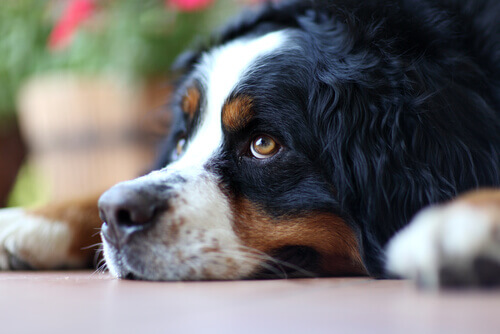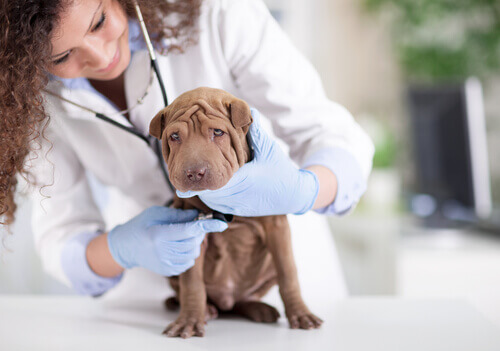Endoscopies in Dogs


Written and verified by the lawyer Francisco María García
Endoscopies in dogs are simple clinical examinations that allow vets to observe and diagnose problems with the gastrointestinal and respiratory tracts. They can then can prescribe the appropriate treatment.
Although this procedure is minimally invasive, it requires that the dog is placed under anesthetic to avoid any accidental discomfort or injury. In this article, we’ll tell you more about endoscopies in dogs and what to expect.
What is an endoscopy?
As we mentioned, this is a clinical exam to check the digestive and respiratory tracts. However, only a vet can perform this procedure. During this procedure, a vet uses a long, thin, very flexible tube. This tube has a tiny chamber at the tip. This apparatus is an endoscope. In fact, it’s how vets get the information they need from this examination.
Inside the endoscope, there’s a small opening that allows a vet to use a wide variety of medical instruments. For this reason, a vet will recommend an endoscopy to diagnose and treat numerous respiratory and gastrointestinal disorders.
This technique has many benefits for the dog, owner, and your vet. In fact, the procedure is simple, painless, and only slightly invasive. It’s also reasonably priced and has a quick recovery time. In addition, it requires little pre and postoperative care, which makes it easier for everyone involved.
How are endoscopies in dogs performed?
Firstly, your vet will make sure that your dog is healthy enough to undergo the procedure. As we previously mentioned, endoscopies in dogs are simple and safe. However, it does involve general anesthetic and is a minimally invasive procedure.

Once you have medical authorization, your dog will be admitted into a veterinary clinic or hospital. Then, a doctor will administer a general anesthetic that usually takes effect almost immediately. Once your dog is properly sedated, the vet will insert an endotracheal tube to allow proper breathing.
Then, the vet will carefully insert the endoscope into your dog’s mouth. The vet will also usually lubricate the tip of the device to allow better access to the digestive tract. The vet will orient the endoscope camera to view all the walls of the gastrointestinal and respiratory system.
Often, it may be necessary to inject a good amount of air through the dog’s mouth to allow better visualization. Then, if the vet finds any foreign bodies, they may choose to make a surgical incision to remove them immediately.
For example, remember that dogs often ingest non-digestible objects that get stuck in their respiratory tract or stomach.
After the procedure, the vet will suck excess air from the gastrointestinal cavity. Then, they will carefully remove the endoscope from the dog’s mouth. Finally, all you have to do is wait for the results, which usually takes between three to seven days. In total, the endoscopy can last between one and three hours. However, the anesthesia should last at least 30 minutes after the procedure finishes.
When are endoscopies in dogs recommended?
Generally, endoscopies are not routine examinations for dogs or humans. In fact, the medical recommendation for this exam usually is due to an abnormal result in a blood test, urine test, ultrasound, or X-ray.

What is the goal of performing an endoscopy? Vets usually perform this procedure to either confirm or rule out a possible diagnosis that they already suspect.
For example, a vet may request an endoscopy to verify the existence of any abnormalities in the dog’s digestive or respiratory system. It also allows the vet to examine the mucosa, as well as collect samples. They will also be able to examine abnormal masses for a subsequent biopsy.
In addition, your vet may use endoscopies in dogs as an immediate treatment or to avoid complications from certain diseases. For example, in the case of gastric torsion or gastropexy, vets use this procedure for the following purposes:
- Placing an intestinal or gastric tube for enteral feeding
- Partial resection of the pancreas and abdomen
- Removing foreign bodies or abnormal masses
Recovery after endoscopies in dogs
Recovery after an endoscopy is usually very simple. Normally, the animal will wake up somewhat disorientated. As a result, you shouldn’t make any sudden movements. Also, while you may want to hug or pet your dog, it’s best to wait until they fully recover consciousness.
You also shouldn’t give your dog food or water after they wake up. Their throat, esophagus, stomach, and intestine will be tender for a few hours.
Due to this sensitivity, it’s important to give your dog small amounts of water, at least 30 minutes after they regain consciousness. Then, you can see if your dog wants to eat three or four hours later. Again, only give them small portions.
This text is provided for informational purposes only and does not replace consultation with a professional. If in doubt, consult your specialist.